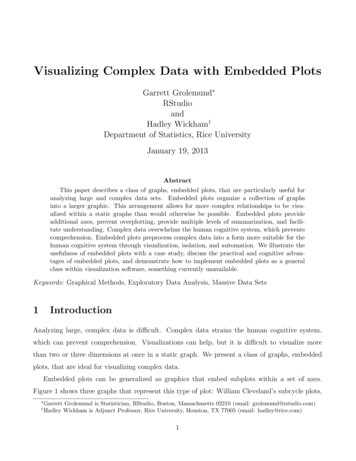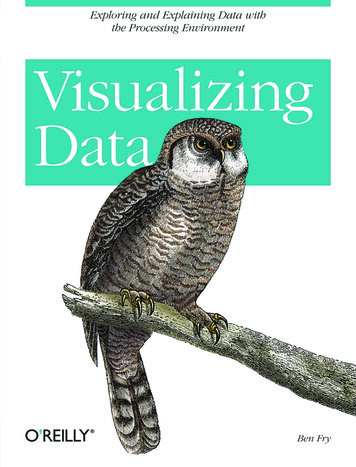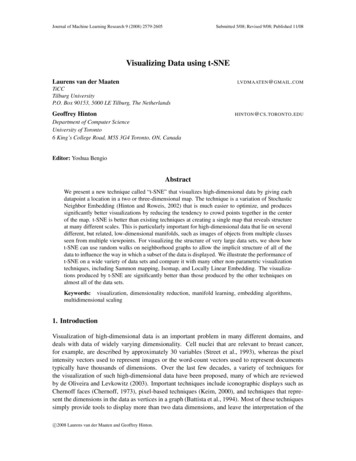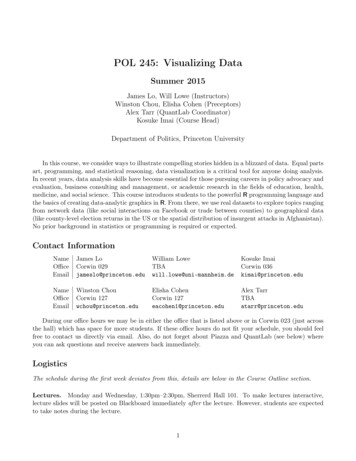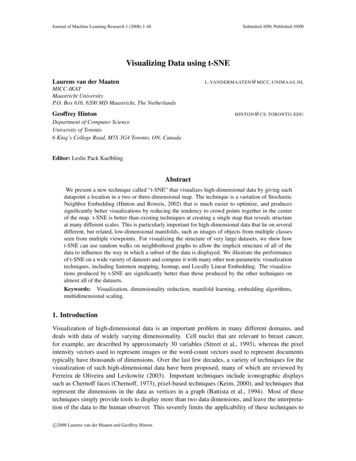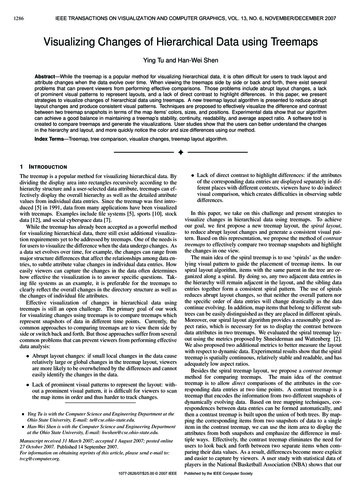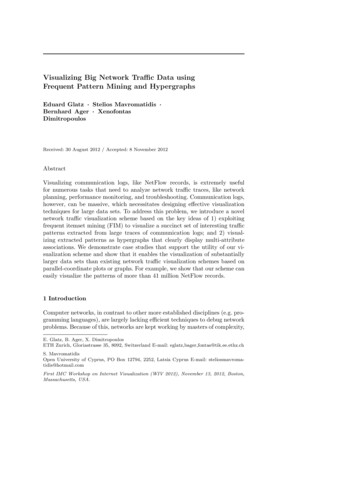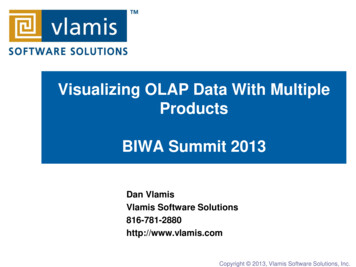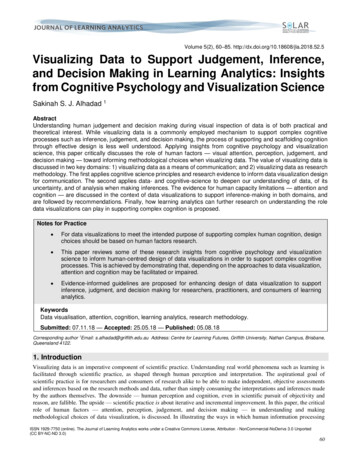
Transcription
Volume 5(2), 60–85. g Data to Support Judgement, Inference,and Decision Making in Learning Analytics: Insightsfrom Cognitive Psychology and Visualization ScienceSakinah S. J. Alhadad 1AbstractUnderstanding human judgement and decision making during visual inspection of data is of both practical andtheoretical interest. While visualizing data is a commonly employed mechanism to support complex cognitiveprocesses such as inference, judgement, and decision making, the process of supporting and scaffolding cognitionthrough effective design is less well understood. Applying insights from cognitive psychology and visualizationscience, this paper critically discusses the role of human factors — visual attention, perception, judgement, anddecision making — toward informing methodological choices when visualizing data. The value of visualizing data isdiscussed in two key domains: 1) visualizing data as a means of communication; and 2) visualizing data as researchmethodology. The first applies cognitive science principles and research evidence to inform data visualization designfor communication. The second applies data- and cognitive-science to deepen our understanding of data, of itsuncertainty, and of analysis when making inferences. The evidence for human capacity limitations — attention andcognition — are discussed in the context of data visualizations to support inference-making in both domains, andare followed by recommendations. Finally, how learning analytics can further research on understanding the roledata visualizations can play in supporting complex cognition is proposed.Notes for Practice For data visualizations to meet the intended purpose of supporting complex human cognition, designchoices should be based on human factors research. This paper reviews some of these research insights from cognitive psychology and visualizationscience to inform human-centred design of data visualizations in order to support complex cognitiveprocesses. This is achieved by demonstrating that, depending on the approaches to data visualization,attention and cognition may be facilitated or impaired. Evidence-informed guidelines are proposed for enhancing design of data visualization to supportinference, judgment, and decision making for researchers, practitioners, and consumers of learninganalytics.KeywordsData visualisation, attention, cognition, learning analytics, research methodology.Submitted: 07.11.18 — Accepted: 25.05.18 — Published: 05.08.18Corresponding author 1Email: s.alhadad@griffith.edu.au Address: Centre for Learning Futures, Griffith University, Nathan Campus, Brisbane,Queensland 4122.1. IntroductionVisualizing data is an imperative component of scientific practice. Understanding real world phenomena such as learning isfacilitated through scientific practice, as shaped through human perception and interpretation. The aspirational goal ofscientific practice is for researchers and consumers of research alike to be able to make independent, objective assessmentsand inferences based on the research methods and data, rather than simply consuming the interpretations and inferences madeby the authors themselves. The downside — human perception and cognition, even in scientific pursuit of objectivity andreason, are fallible. The upside — scientific practice is about iterative and incremental improvement. In this paper, the criticalrole of human factors — attention, perception, judgement, and decision making — in understanding and makingmethodological choices of data visualization, is discussed. In illustrating the ways in which human information processingISSN 1929-7750 (online). The Journal of Learning Analytics works under a Creative Commons License, Attribution - NonCommercial-NoDerivs 3.0 Unported(CC BY-NC-ND 3.0)60
capacities can alter the physical representation of data to create meaning, the fallacy of neutrality or fundamental objectivityof data (Gelman & Hennig, 2017; Woodward, 2011) is also addressed.Learning analytics research is inherently embedded in educational practice, and thus has a clear role in influencingeducational practice and policy. The field, therefore, is uniquely positioned to meet the increasing demand for accessible andrelevant evidence-based approaches to support emerging educational practice. Given that learning analytics research oftenfocuses on unobtrusive measures such as log file, or physical traces to complement existing and new educational methods, theresearch ethos accommodates convergent measures for understanding learning in educational complexity. Hence, critical tothe learning analytics field is not only visualization of potentially large datasets, but also of meaningful connections betweendatasets. Given the complexity of learning data, substantial resources are required to create effective data visualizations forcomprehension and communication of the research. Navigating decision making for the optimal data visualization strategiesto facilitate understanding of complex, interrelated datasets can be onerous, but is crucially important in enabling discovery ofkey patterns and connected understanding. The challenge for us is to effectively translate and integrate the existing researchfindings from related fields into learning analytics research.As researchers, we tend to be appropriately cautious in the inferences we draw from our research. This caution in drawingconclusions is largely due to recognizing the difficulty in controlling for, or accounting for, all of the potentially importantconstructs/variables in a complex phenomenon of interest. How then, do researchers make decisions about ways to representresearch data as visualization effectively and accessibly, while retaining scientific integrity? The aim of this paper is to provideevidence-based suggestions to inform decision making when considering data visualization methods. Drawing from cognitivepsychology, data science, and the human–computer interaction literature, this paper highlights ways in which design decisionsfor static data visualizations can have downstream implications for judgement and decision making for two main purposes: 1)data visualization as a tool for communicating research, and 2) data visualization as a tool for understanding research. The firstfocuses on the evidence and practical recommendations on the basis of human visual perception and cognition in constructingdata visualizations to communicate data as informed by evidence to support cognitive processes of inference. The second partfocuses on the importance of data visualization for researchers in gaining a deeper understanding of their research data.Collectively, these can inform decisions for visualizing learning analytics for quality inference-making.2. Data Visualization as Situated Information2.1. A priori methodological decision making: The false dichotomy of objectivity–subjectivity of data inscientific reasoningData serves the purpose of enhancing our understanding about phenomena in the world, and is contextualized within researchmethodology. Accordingly, it stands to reason that the objective of “objectivity” in science can be in and of itselfphilosophically and epistemically misleading. Gelman and Hennig (2017) proposed that to move statistical discourse towardsprinciples of good science, we ought to replace the false (and potentially misleading) dichotomy of “subjectivity” or“objectivity” in statistics discourse with broader collections of attributes. In shifting the discourse within these broaderattributes such as transparency and consensus instead of “objectivity,” and awareness of multiple perspectives and contextdependence instead of “subjectivity,” we make explicit and acknowledge the real value of subjectivity in ways that make clearthe different ways of knowing in making sense of the world. This view is consistent with what cognitive science tells us abouthow humans make meaning from information, and recognizes that data and statistics cannot exist without the situated contextof research methodology in inference making. A priori methodological decisions including sampling techniques, experimental(or non-experimental) design, or methods of dealing with missing data or outliers are similarly subjected to complex humancognitive processes. As Woodward (2011, p. 172) argues, “Data to phenomena reasoning, like inductive reasoning generally,is ampliative in the sense that the conclusion reached (a claim about phenomena) goes beyond or has additional content besidesthe evidence on which it is based (data).” Hence, for epistemological and methodological reasons, it is important for us torecognize in explicit terms that human information processing complexities are the basic conditions of scientific inquiry towardimproving the transparency of scientific reasoning.2.2. Toward human-centred data visualization: Understanding human perception and cognitionOne of the key mechanisms for understanding and communicating scientific findings is through visualization of data. Inlearning analytics, data visualization is a core aspect of understanding and communicating research, and also part of the objectof research and practice. Data visualizations are central in learning analytics work related to the provision of data to supportlearning and teaching to both learners and teachers (e.g., Clow, 2013; Gašević, Kovanović, & Joksimović, 2017; Verbert etal., 2014) in various methods (static, dynamic, table top, multimodal, dashboards). The informative power of data visualizationin research and practice is as germane in learning analytics as in other domains of complex research phenomena. Hence,ISSN 1929-7750 (online). The Journal of Learning Analytics works under a Creative Commons License, Attribution - NonCommercial-NoDerivs 3.0 Unported(CC BY-NC-ND 3.0)61
understanding the mechanisms by which data visualization can support or hinder cognition is extremely valuable for learninganalytics researchers and practitioners — there is much for the field to offer in this regard.Data visualizations are visual representations of complex information, constructed in ways to enhance understanding(Ward, Grinstein, & Keim, 2015). In principle, the purpose and outcome of visual representations is that they can supportcognition (Hegarty, 2011). There are many convincing arguments why visualization in research is important. Visualizing datashould be part of the core communication strategy, and is as vital to this goal as are research methodology and statisticalanalyses. Data visualization enables communication of complex patterns that sometimes cannot be, or are cumbersome toconvey in words (Ward et al., 2015). Visualizing data facilitates identification of patterns otherwise obscured in text or tables(Cleveland, 1994; Gelman, Pasarica, & Dodhia, 2002; Kastellec & Leoni, 2007; Tufte, 2001; Ward et al., 2015), particularlyfor multivariate relationships (Meyer, Shamo, & Gopher, 1999; Porat, Oron-Gilad, & Meyer, 2009). However, even with thehigher order advantage of visualizing data to aid comprehension, there is evidence for interpretative bias (e.g., Braithwaite &Goldstone, 2013; Newman & Scholl, 2012; Shah, Mayer, & Hegarty, 1999). This necessitates careful and deliberate designand communication when visualizing data. How these external representations of data interact with people’s internal cognitiveprocesses for inference-making and knowledge construction is of primary importance in informing strategies for effective datavisualizations.In some ways, we have learnt a lot in the last twenty years or so; in other ways, some of the key challenges of the field —developing ways of systematically collaborating across disciplines, or challenging assumptions or misconceptions about whatis effective design for visual representations (Scaife & Rogers, 1996; Wilkinson & Task Force on Statistical Inference, 1999)— are still as pertinent today. In moving forward, there is a substantial body of research that we can leverage to inform ourdecisions when visualizing data for inference-making. While comprehension of these data visualizations may vary acrossindividuals (e.g., Conati & Maclaren, 2008; Toker, Conati, Steichen, & Carenini, 2013), the underlying mechanismsresponsible for human cognition are generalizable.3. Data Visualization as CommunicationIn this section, insights from cognitive psychology are synthesized to facilitate the bridging of human information processingand visualizing data as communication. This research forms the basis of evidence-based guidelines for constructing datavisualizations to support cognition (see Table 1/Appendix A for a summary). Processing data visualizations, particularly in thecontext of education (specifically learning analytics), is not only cognitive. Emotions, for instance, play a complex, interactiverole in processing information generally (see Yiend, 2010, and Barrett, 2017, for reviews), notwithstanding data visualization.The complex role that emotions play at various levels of engagement with data visualizations is beyond the scope of this paper(see Kennedy & Hill, 2017, for emerging research in this area).3.1 Attention is limited and selective3.1.1. Bottom-up versus top-down attentional mechanismsOne of the most robust findings in cognitive psychology is that the human capacity for processing information is limited. Inthe case of processing visual information, only a small amount of information available to the retina can be processed at anygiven time. Thus, visual attention and eye movements are often closely coupled, though attention can occur outside of theconstraints of the visual field (see van Zoest, Van der Stigchel, & Donkl, 2017). Given complex environments of multiplepossible inputs, the cognitive system selectively prioritizes some items for further processing, while others are effectivelyattenuated. According to the biased competition account of attentional selection (Desimone & Duncan
Visualizing data is an imperative component of scientific practice. Understanding real world phenomena such as learning is facilitated through scientific practice, as shaped through human perception and interpretation. The aspirational goal of scientific practice is for researchers and consumers of research alike to be able to make independent, objective assessments and inferences based on the .
